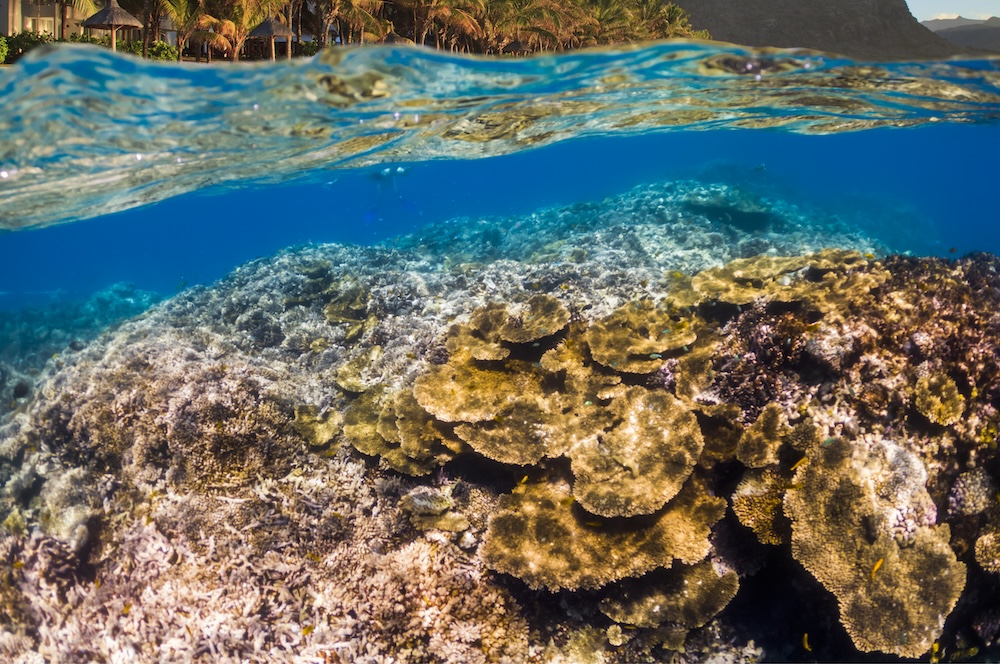Beneath the surface of the world’s oceans, a quiet transformation is underway. As carbon dioxide levels rise in the atmosphere, much of it is absorbed by seawater — changing the very chemistry that marine life depends on. This process, known as ocean acidification, is weakening coral reefs from the inside out.
While coral bleaching is the visible face of reef decline, acidification is the invisible hand eroding their foundations, one molecule at a time.
The Chemistry of Change
The ocean absorbs about 30% of the carbon dioxide humans release into the atmosphere. When CO₂ dissolves in seawater, it reacts to form carbonic acid, which lowers the water’s pH.
As acidity increases, carbonate ions — the building blocks corals need to form their calcium carbonate skeletons — become less available. Corals are left struggling to grow, repair, and even maintain their existing structures.
In short: the ocean is becoming too acidic for reefs to build themselves.
How Acidification Weakens Coral
1. Slower Growth and Fragile Skeletons
Corals depend on a delicate balance of calcium and carbonate to build their skeletons. With fewer carbonate ions available, new coral growth slows dramatically.
Existing coral structures begin to dissolve faster than they can be rebuilt. Over time, this leads to weaker, more brittle reefs that are easily damaged by storms, waves, and human activity.
2. Impaired Reproduction and Larval Survival
Acidic waters interfere with coral reproduction. Larvae have difficulty forming early skeletons, settling on reef surfaces, and surviving in low-pH conditions. This means fewer young corals to replace those lost — an unseen decline in the next generation of reefs.
3. Chain Reaction Through the Ecosystem
When coral structures weaken, the life they support weakens too. Fish lose habitat. Algae overgrow dead coral. Species that depend on reefs for food or shelter are forced to migrate — or perish.
The collapse starts chemically, but it ends ecologically.
How Fast It’s Happening
Ocean pH has dropped by about 0.1 units since the Industrial Revolution — a 30% increase in acidity. That might sound small, but in ocean chemistry, it’s a seismic shift.
By 2100, scientists project another 0.3 to 0.4 decrease in pH if emissions continue unchecked. For coral reefs, that’s the difference between growth and dissolution.
At current rates, some reef-building corals could stop forming skeletons altogether within this century.
What Makes Coral So Vulnerable
Unlike many marine organisms, corals can’t simply move to less acidic waters — they are rooted to their foundations. Their internal symbiosis with algae (zooxanthellae) is already strained by warming temperatures. Acidification adds a second layer of stress, one that undermines even healthy, non-bleached reefs.
This means that even if global temperatures stabilize, acidification can continue to erode coral resilience for decades.
The Global Impact
Biodiversity Collapse
Coral reefs support a quarter of marine life. As they weaken, thousands of species lose their homes and feeding grounds, destabilizing entire oceanic food webs.
Food and Livelihood Insecurity
Millions of people depend on reef fisheries for protein and income. Acidification threatens this supply chain — not only by reducing fish populations but by degrading the nursery grounds that sustain them.
Coastal Protection Loss
Weakened reefs can no longer buffer shorelines from waves and storm surges. The natural protection they provide — worth an estimated $9 billion annually — diminishes as the reef’s structure erodes.
Economic and Cultural Loss
Tourism, coastal economies, and cultural traditions tied to reef ecosystems face irreversible decline if reefs collapse.
Hope in Restoration and Reduction
The chemistry that causes ocean acidification can’t be reversed overnight, but it can be slowed — and its impacts mitigated.
Reduce CO₂ Emissions
The only long-term solution is cutting carbon emissions. Every ton of CO₂ avoided means less acid forming in the ocean.
Restore Seagrass and Mangroves
These coastal ecosystems absorb CO₂ and locally buffer acidity, creating micro-refuges where corals can survive.
Protect Reef Resilience
Reducing local stressors like pollution, overfishing, and runoff gives corals a better chance to adapt.
Support Scientific Innovation
Researchers are exploring coral species that tolerate lower pH levels and experimenting with assisted evolution — a potential lifeline for vulnerable reef systems.
What You Can Do
- Choose renewable energy whenever possible.
- Support reef-safe and carbon-conscious products.
- Avoid waste and single-use plastics that contribute to ocean carbon loads.
- Share awareness — most people still think bleaching is the only coral threat.
Every action that cuts emissions or protects water quality helps shift the ocean’s chemistry in the right direction.
FAQs
Does ocean acidification only affect coral reefs?
No. It impacts shell-forming species like oysters, clams, and plankton, disrupting entire marine food webs.
Can coral adapt to acidification?
Some species show resilience, but adaptation takes generations. Acidification is happening too quickly for most to keep up.
Is local action enough?
Local efforts help, but global carbon reduction is essential. Coral reefs can’t outgrow chemistry.
Final Thoughts
Ocean acidification is a silent crisis — one that doesn’t make headlines like oil spills or bleaching events, yet it weakens the very skeleton of the ocean’s living architecture.
Every coral polyp, every reef fish, and every coastline protected by reefs depends on one fragile equation: balance.
If that balance tips too far, the world’s most vital marine ecosystems will dissolve, not in catastrophe — but in silence.
Protecting coral reefs means protecting chemistry itself — the invisible foundation of life on Earth.









Reader Interactions